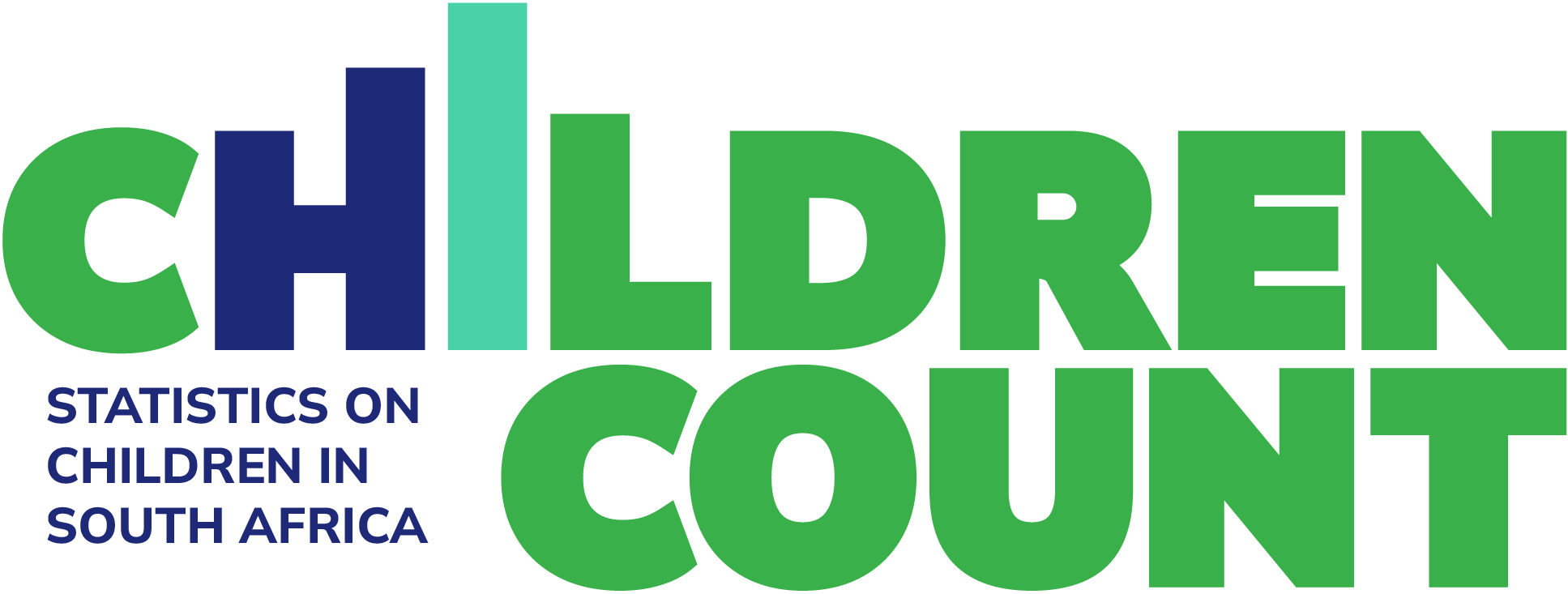A child-only household is defined as a household in which all members are younger than 18 years. These households are also commonly referred to as “child-headed households”, although this definition differs from the technical definition contained in the Children’s Act.
The Children’s Act definition of a child-headed household includes households where there are adults who may be too sick or too old to head the household effectively and a child over 16 years bears this responsibility. It is not possible to count this type of child-headed household from the available survey data, as the designation "child-headed household" can only be conferred by the provincial Department of Social Development, To date, there are no administrative data available on the number of designated child-headed households.
Analysis by Katharine Hall & Sumaiyah Hendricks, Children’s Institute, University of Cape Town.
- Children are defined as persons aged 0 – 17 years.
- Population numbers have been rounded off to the nearest thousand.
- Sample surveys are always subject to error, and the proportions simply reflect the mid-point of a possible range. The confidence intervals (CIs) indicate the reliability of the estimate at the 95% level. This means that, if independent samples were repeatedly taken from the same population, we would expect the proportion to lie between upper and lower bounds of the CI 95% of the time. The wider the CI, the more uncertain the proportion. Where CIs overlap for different sub-populations or time periods we cannot be sure that there is a real difference in the proportion, even if the mid-point proportions differ. CIs are represented in the bar graphs by vertical lines at the top of each bar.
In 2024 there were an estimated 30,000 children living in child-only households. This equates to less than 0.2% of all children. Because this household form is rare and even a large population survey like the GHS encounters very few, the confidence intervals in the data are quite wide and the weighted number may lie within a margin of around 10,000 around either side of the mid-point estimate.
Importantly, there has been no increase in the share of children living in child-only households in the period 2002 – 2022, even at the height of the HIV pandemic. If anything, the number has dropped, and there has been a statistically significant drop in both Limpopo and the Eastern Cape, provinces with the highest baseline numbers. Predictions of rapidly increasing numbers of child-headed households as a result of HIV orphaning were unrealised, and similarly there seems to be no sign of a spike in child-headed households during the COVID-19 pandemic,
In line with previous studies that examined the circumstances of children in child-headed households in South Africa [1] the data suggest that most children in child-only households are not orphans: 85% of children in child-headed households have a living mother and 90% have at least one living parent. These findings suggest that social processes other than mortality influence the formation of these households. For example, a family may decide to leave teenage boys to look after a rural homestead while parents migrate to work because this is a necessary livelihood strategy: the family needs income but the family home also needs to be maintained, or there is no suitable space for co-resident children to join parents in the places where they seek work.
While it is not ideal for any child to live without any coresident adults, it is positive that most children living in child-only households are 15 or older. In the 2024 GHS, less than 20% of children in identified child-headed households were under 10 years of age, while 70% were 15-17 years old.
Previous research suggests that child-only households are often temporary arrangements, existing just for a short period, for example while adult migrant workers are away, or for easy access to school during term time, or after the death of an adult and prior to other arrangements being made to care for the children (such as other adults moving in or the children moving to live with other relatives).[2] Also, Stats SA surveys use a narrow definition of the household, which requires that members stay in the household at least four nights a week to be counted as part of the household. Some children in the sampled child-only households might have adult family members who return on weekends.
Relative to children in mixed-generation households, child-only households are vulnerable in a number of ways. Child-only households identified in the GHS are overwhelmingly in the poorest households. In addition to the absence of adult members who may provide care and security, they are at risk of living in poorer conditions, with poor access to services, less (and less reliable) income, and low levels of access to social grants.
There has been very little robust data on child-headed households in South Africa to date. The figures should be treated with caution as the number of child-only households forms just a very small sub-sample of the GHS. In 2024, only 48 children (unweighted) were identified as being in child-headed households, out of a sample of 24,000 children.
The share of children living in child-only households in South Africa is calculated by identifying the number of children living in households where the oldest resident is no older than 17 years, and dividing this figure by the total child population in South Africa.
The share of child-only households is calculated by dividing the number of households where the oldest resident is no older than 17 years, by the total number of households in South Africa.
The figures should be treated with caution as the number of child-only households form just a very small sub-sample of the General Household Survey, which reduces the reliability of the weighted total. In particular, we caution against reading too much into the provincial breakdowns, or into apparent differences between the estimates from different years.
The GHS uses a Master Sample frame which has been developed as a general-purpose household survey frame that can be used by all other Stats SA household-based surveys that have design requirements that are reasonably compatible with the GHS. The sample is drawn from Census enumeration areas using a stratified two-stage design with probability proportional to size sampling of PSUs in teh first stage, and sampling of dwelling units with systematic sampling in the second stage. The resulting sample consists of just over 20,000 households with around 70,000 individuals, and should be representative of all households in South Africa. It is also designed to be representative at provincial level and within provinces at metro/non-metro levels and three geography types (urban areas, rural areas under traditional authority, and farms).
The sample consists of households and does not cover other collective institutionalised living-quarters such as boarding schools, orphanages, students’ hostels, old-age homes, hospitals, prisons, military barracks and workers’ hostels. These exclusions probably do not have a noticeable impact on the findings in respect of children.
Changes in sample frame and stratification
Since 2014 the GHS has been based on the 2013 master sample that that is, in turn, based on information collected during the 2011 Population Census. The previous master sample for the GHS was used for the first time in 2008, and the one before that in 2004. These again differed from the master sample used in the first two years of the GHS: 2002 and 2003. Thus there have been four different sampling frames during history of the annual GHS, with the changes occurring in 2004, 2008 and 2013. In addition, there have been changes in the method of stratification over the years. These changes could compromise comparability across iterations of the survey to some extent, although it is common practice to use the GHS for longitudinal monitoring and many of the official trend analyses are drawn from this survey.
Weights
Person and household weights are provided by Stats SA and are applied in Children Count analyses to give population estimates on the indicators. The GHS weights are derived from Stats SA’s mid-year population estimates for the relevant year. The population estimates are based on a model that is revised from time to time when it is possible to calibrate the population model to Census data and larger population surveys such as the Community Survey.
In 2017, Stats SA revised its demographic model to produce a new series of mid-year population estimates and the GHS data were re-released with the revised population weights. All the Children Count indicators were re-analysed retrospectively, using the revised weights provided by Stats SA, based on the 2013 model. The estimates are therefore comparable over all years. The revised weights particularly affected estimates for the years 2002 – 2007.
The 2017 model drew on the 2011 census, along with vital registration, antenatal and other administrative data, but was a “smoothed” model that did not mimic the unusual shape of the age distribution found in the census. The results of the 2011 census were initially distrusted because it seemed to over-count children in the 0 – 4 age group and under-count children in the 4 – 14-year group. It is now thought that the fertility rates recorded in the 2011 population census may have been an accurate reflection of demopraphic trends, with an unexplained upswing in fertility around 2009 after which fertility rates declined again gradually. Similar patterns were found in the vital registration data as more births were reported retrospectively to the Department of Home Affairs, and in administrative data from schools, compiled by the Department of Basic Education. In effect, this means that there may be more children in South Africa than appear from the analyses presented in these analyses, where we have applied weights based on a model that it is now known to be inaccurate.
Stats SA has subsequently developed a new population model - the 2022 series, which provides revised mid-year population estimates back to 2002 and projected to 2032. However, the GHS series has not yet been reweighted.The population estimates in Children Count are therefore based on weights derived from outdated population model (2017). It is not yet clear when and how the population model will be revised again following the 2022 Census, as there are concerns around census under-count and plausibility of its findings.
Disaggregation
Statistics South Africa suggests caution when attempting to interpret data generated at low level disaggregation. The population estimates are benchmarked at the national level in terms of age, sex and population group while at provincial level, benchmarking is by population group only. This could mean that estimates derived from any further disaggregation of the provincial data below the population group may not be robust enough.
Reporting error
Error may be present due to the methodology used, i.e. the questionnaire is administered to only one respondent in the household who is expected to provide information about all other members of the household. Not all respondents will have accurate information about all children in the household. In instances where the respondent did not or could not provide an answer, this was recorded as “unspecified” (no response) or “don’t know” (the respondent stated that they didn’t know the answer).
For more information on the methods of the General Household Survey, see the metadata for the respective survey years, available on Nesstar or DataFirst

 The SAECR 2024 tracks trends on the status of children under 6.
The SAECR 2024 tracks trends on the status of children under 6. 











